|
Misja K. 2005. Fluturat e Shqipërisë. Macrolepidoptera (Rhopalocera, Bombyces & Sphinges, Noctuidae, Geometridae).
1. Pjesa e përgjithshme I.1. Grumbullimi i fluturave, përpunimi dhe formimi i koleksioneve.
Akademia e Shkencave e Shqipërisë, Instituti i Kërkimeve Biologjike,Tiranë, p 16-19.
Translated and adapted with notes (in blue)
General part I.1. Collecting butterflies, processing samples and building reference collections.
Butterflies are collected with an entomological net. The net consists of metal rings with a diameter of 30-50 cm made of wire with a thickness of 0.3-0.5 cm and a thin meringue basket, made of cotton or synthetic material, with a length of 60-80 cm. The ends of the metal ring are joined in different ways with the light wooden stick that has a length of 110-130 cm. The meringue basket is reinforced in the upper part, between which it is connected to the metal ring, with thick fabric or cambric.
To be easily transported in the field, the ring and stick can be made up of 2-3 detachable parts.
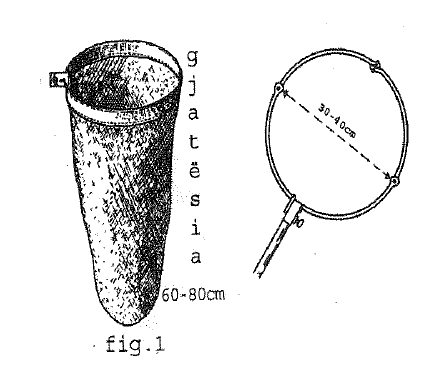 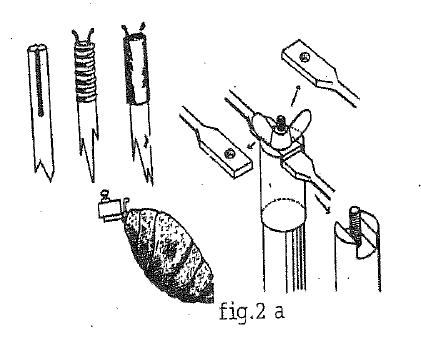
Scans from Misja (2005): Fig.1 and Fig.2a.
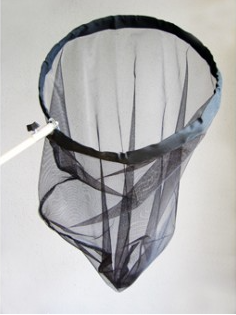 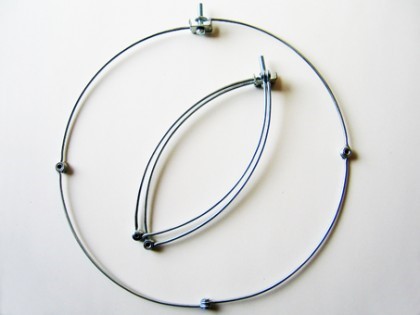 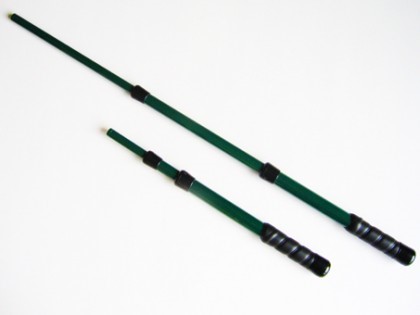
Commercial material is available from entomological equipment suppliers.
The method of catching butterflies requires attention to ensure that the collected individuals are not damaged. After catching the butterfly, the net is quickly folded, directing the opening of the net downwards.
After this action, the basket of the entomological net is directed towards the sun to enable the identification of the insect. Once the butterfly has been identified and will be sampled for a reference collection, the insect is lightly and carefully pressed with the tips of the thumb and index finger on the chest without touching the wings.
Then the butterfly is taken out of the net by catching it on the body with tweezers and placed in a paper envelope, in which the place, coordinates, date of capture and the name of the collector are noted.
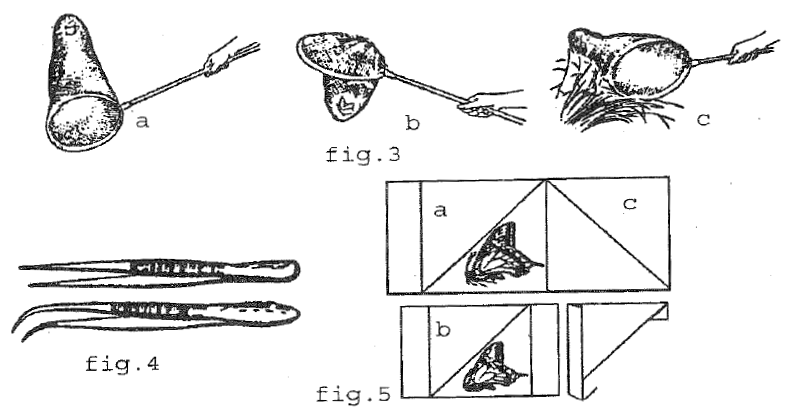
Scans from Misja (2005): Fig. 3-5.
To avoid damage, the envelopes are placed in a bag made of thick cloth or leather, which is tied around the waist.continue.
In the notebook, for each of the collection stations, data on the habitat and vegetation are recorded.
Note: to maximize the time for field surveying and minimize the time for adminstration, we suggest to label the envelopes with a single code: date and site.
For example: 2022 v 20 A, 2022 v 20 B etc.
Working per surveyed site (A, B, ...) during a single day, the samples can be stored in separate small metallic or tupperware boxes and kept cool and dry in your pockets or in a back pack.
Samples that are intended for genetic research should be dried asap for optimal conservation of DNA.
Keep these boxes open when leaving the field. During an expedition put the boxes, without pressing the envelopes, in the car in a sunny place. Be careful when driving from one site to another!
The time consuming, administrative work of labeling each envelope can be done in the evening while databasing the observations of each site.
A notebook can be replaced by an Excel file, bringing together all the data from the field day. The identification of some specimens, needing further research, can be marked in the database till the correct information is available. More columns can be added to provide additional information about habitat, status of the research, ...
Data on habitat and vegetation can be documented by photograps.

An example of a potentail Excel file for databasing field observations using a unique code per specimen.
The collected material is placed in the freezer of an ordinary refrigerator for a minimum of 1 week until its processing.
Collected butterflies are prepared for collection in laboratory conditions. The dried material after being taken out of the freezer must be hydrated so that the insect can be processed easily. A glass desiccator is used for this purpose. Boiled water is poured into the bottom of the desiccator. An absorbent paper is placed on the wire plate in which the butterflies to be tamed are placed. The desiccator is closed with its cover as its closing surface is coated with petroleum jelly (or soft paraffin). The insects are kept for 24 hours in a hermetically sealed desiccator.
In the absence of a desiccator, a plastic container with a lid can be used. The container should be 20-30 cm deep. The plastic container is filled with sand to a height of about 5 cm. The sand is wetted with hot water before starting the insect hydration procedure. After that, a plastic net is laid on the surface of the sand, and an absorbent paper is placed on top of it. Place the butterflies that will be hydrated on absorbent paper. The insects are kept in a hermetically sealed box for 24 hours. To prevent the material from getting moldy, disinfectant (thymol) is added to the surface of the sand from time to time.
The softened material is left for a while to let the moisture escape and then the preparation begins according to the following procedure. To form the collections necessary for any biological study, the butterflies are lifted carefully so as not to damage the wings, antennae and legs. For this purpose, butterfly setting boards made of soft wood (poplar wood) are used, in which entomological needles are easily inserted. One wing of the butterfly setting board is usually movable to adjust the width of the groove that is formed between them, according to the thickness of the butterfly's body. The grooved end is made of cork or other soft material to easily attach the needle. The sizes of the butterfly setting board are different, usually they are 30-35 cm long with the width of each wing 3-6 cm according to the size of the butterflies. Foam bases setting board can be also used.
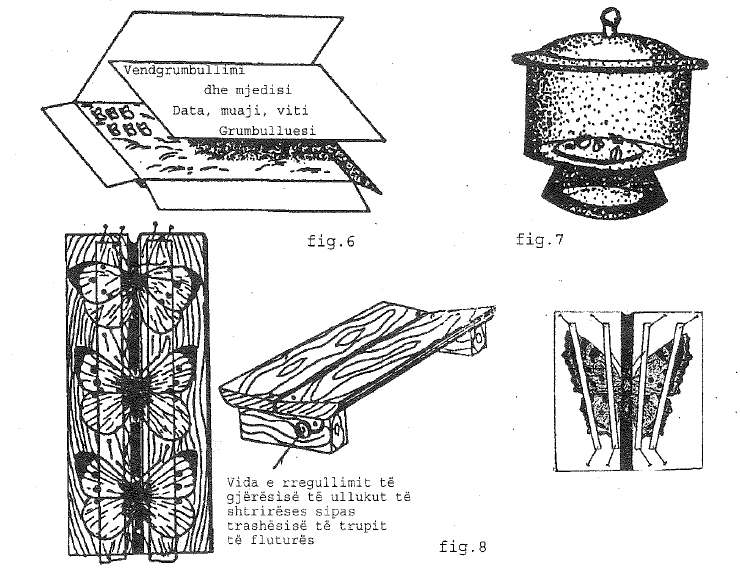
Scans from Misja (2005): Fig. 6-8.
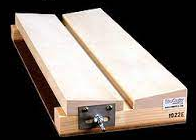 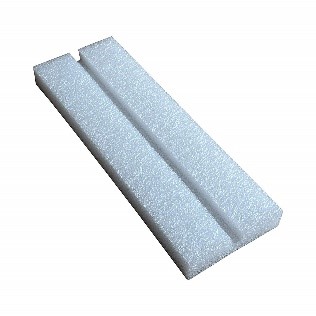
Commercial material is available from entomological equipment suppliers.
For the preparation of butterflies for entomological collections, entomological stainless steel (black) needles with numbers 003-7 are used, combining the size of the butterfly with the number of the needle. The entomological needles are 36-38 mm long, made of non-oxidizing material. The needles are inserted perpendicularly into the thorax of the butterfly, between the front and middle legs, making sure that 1/3 of the length of the entomological needle stays above the surface of the butterfly's body, while 2/3 below it.
Laying the wings of the butterfly during this process requires great care. Using laboratory forceps and needles, stretch the wings so that the trailing edge of the front wings forms a right angle (90) with the axis of the butterfly's body.
The extended wings are covered with paper strips (it is better to use transparent paper) so that they do not move during the drying time. The thickness and length of the paper strips is in accordance with the size of the butterfly. The paper strips are fixed to the butterfly setting board with ordinary pins. The antennae are carefully stretched and held in the desired position with pins until the butterfly is completely dry.
Note: There are now also pergamine setting strips of different widths: 10 -40 mm (Figure)
1/ They are semitransparent what I personally use during the preparation.
2/ They will completely cover the wings and antennae = avoiding potential damage during manipulations.
Clubs of antennae are sometimes useful for identification and easily lost during this process.
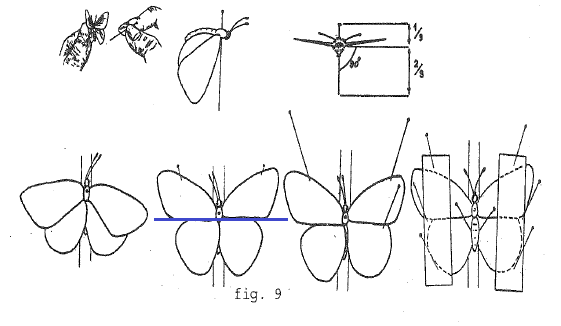 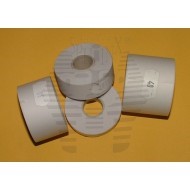
Scans from Misja (2005): Fig. 9.
Right: commercial material is available from entomological equipment suppliers.
For each individual a paper label is prepared, which is placed on the right side of it.
The name of the station where the butterfly was collected, the coordinates, the date and the name of the collector are recorded on the label.
Butterflies prepared in this way are dried for several days in closed shelves to avoid damage.
When the butterflies are large, they are dissected in the abdomen, the internal organs are removed and the abdomen is filled with cotton.
Note: There is not a single Albanian butterfly species that requires this manipulation. This is common practice for big Grashoppers and Dragonflies as they change of colours while drying.
After identifying the species, a second label is prepared for each dried butterfly, where the scientific name of the species and that of the identifier are noted.
The butterflies accompanied by the corresponding labels are placed in entomological collection boxes, which usually measure 40x50x6 cm. These boxes must be hermetically sealed to prevent pests from entering. Bags with an insecticidal agent are placed in each box.

Scans from Misja (2005): Fig. 10.
Contact
|
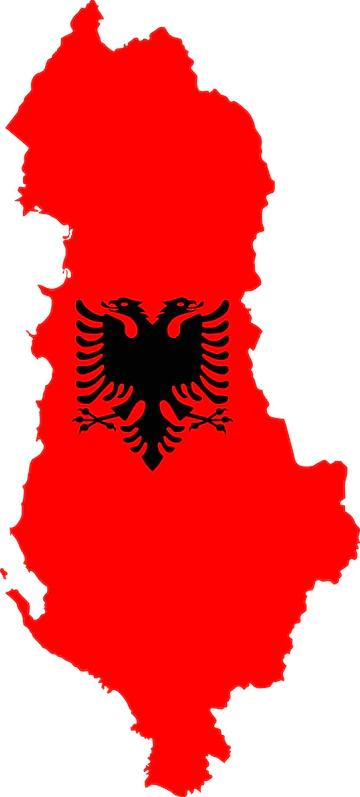 xx
xx 












